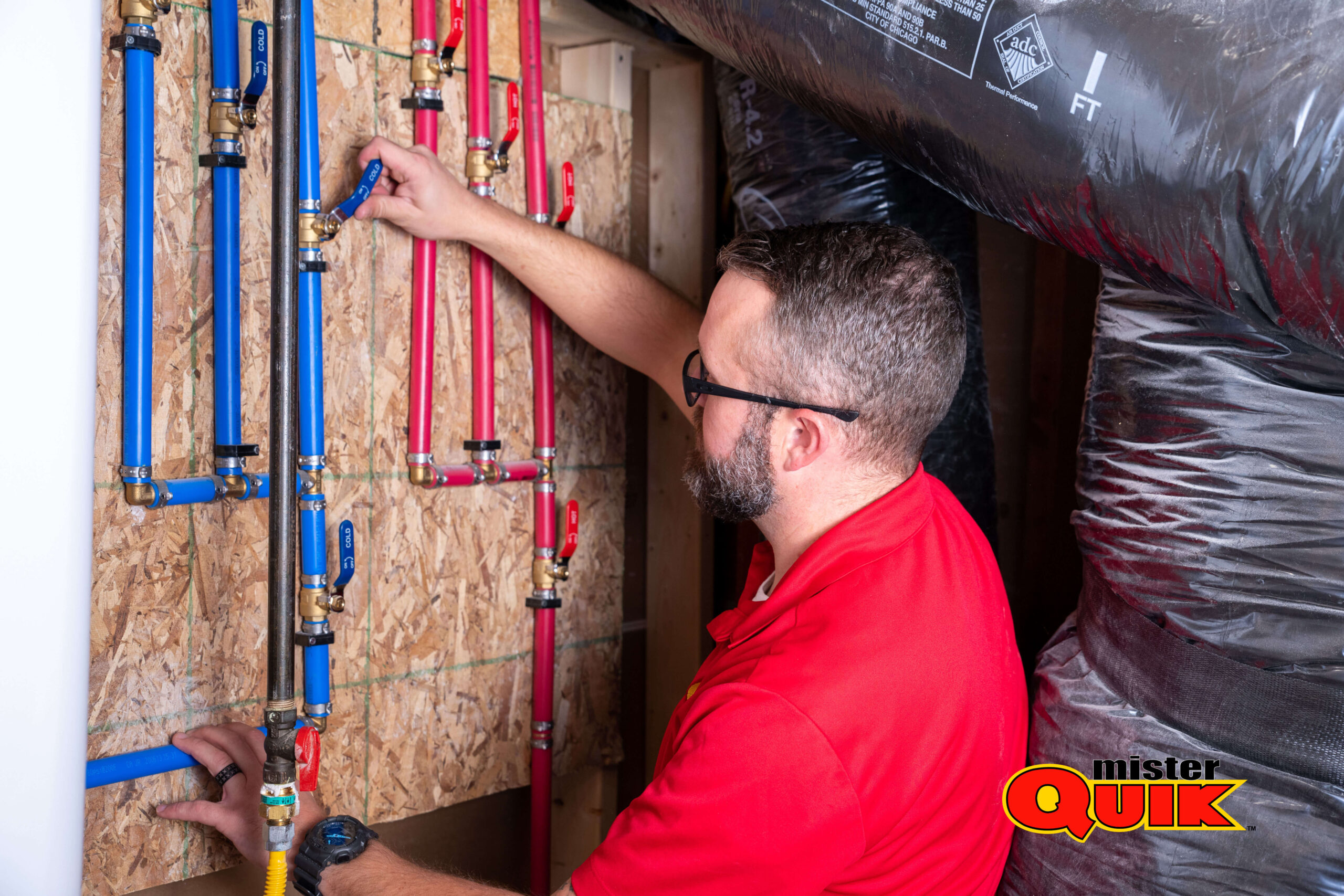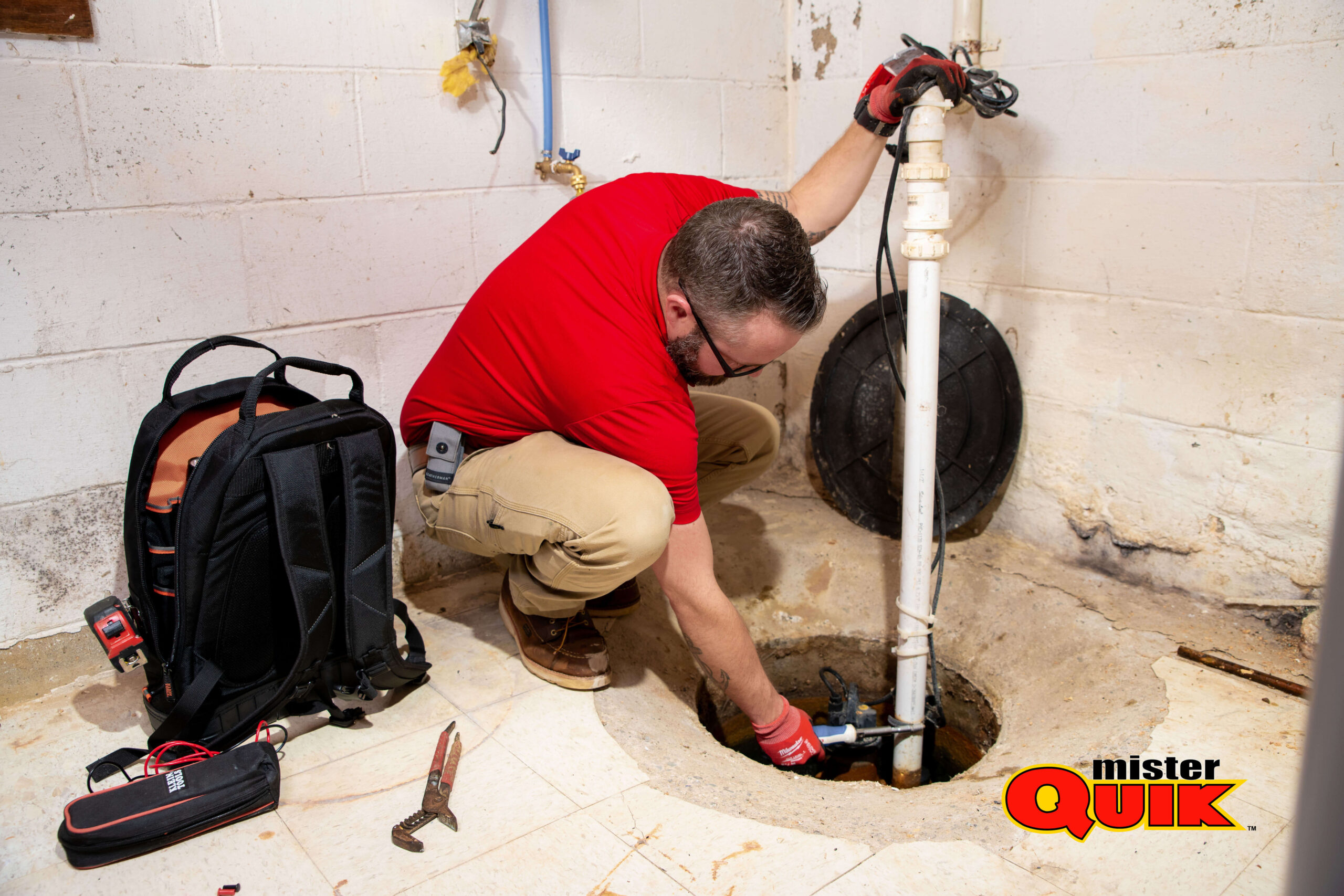Noblesville Water Leak Repair

Water Leak Detection
Leaking pipes can be a hidden menace in your home, causing potential water damage, wasted resources, and increased water bills. Fortunately, several methods can help you detect leaks, even the ones hiding behind walls or underground.
- Monitor Your Water Meter:
- This is a simple yet effective method. Locate your water meter, usually near the point where water enters your house (often in the basement, garage, or near the curb).
- Turn off all water-using appliances and fixtures in your house.
- Observe the water meter dial: If the dial is moving even though no water is being used, it indicates a potential leak somewhere in your plumbing system.
- Check Your Water Bill:
Compare your recent water bills with those from previous months. A significant and unexplained increase in water usage can be a sign of a hidden leak.
- Look for Visible Signs of Leaks:
- Be observant for any signs of water damage, such as:
- Damp spots or discoloration on walls, ceilings, or floors.
- Mold growth, especially in areas with poor ventilation.
- Peeling paint or wallpaper.
- Cracks in foundation or basement walls.
- Listen for Unusual Sounds:
Running water sounds when no faucets are open can indicate a leak. This might be a faint trickling or a more noticeable hissing sound, depending on the severity of the leak.
- Utilize Leak Detection Tools:
- Electronic leak detectors: These handy tools use sound or moisture sensors to pinpoint the location of leaks. While not always foolproof, they can be a helpful starting point.
- Stethoscopes: Professionals often use stethoscopes to listen for water flow sounds near pipes to locate leaks. You can try using one yourself, focusing on areas near walls, under sinks, and around fixtures.
If you suspect a leak, it’s crucial to take action:
- Turn off the main water supply valve to prevent further water damage.
- Call a licensed plumber to diagnose the leak and recommend the appropriate repair solution.
Remember: Early detection and prompt action are key to minimizing the damage and cost associated with water leaks. By being vigilant and utilizing these detection methods, you can address leaks effectively and maintain a healthy plumbing system in your home.
Signs of Water Damage in Walls
Signs of Water Damage in Walls: Detecting the Hidden Threat
Water damage in walls can often go unnoticed for a while, leading to extensive repairs and potential health risks if left unchecked. Here are some key signs to watch out for:
Visual Signs:
One of the most evident signs is discoloration on the wall surface. Look for brownish-yellow stains, which are common indicators of water damage. The specific shade and pattern of the discoloration can vary depending on the source and severity of the leak.
Water seeping through the drywall can cause paint or wallpaper to peel or bubble. This is because the material loses its adhesion to the wall due to moisture exposure.
In cases of prolonged or extensive water damage, the drywall itself can become compromised. You might observe warping, where the wall appears to bend or bulge outwards, or even sagging, where the wall seems to droop downwards due to the weight of the water.
Damp environments created by leaks are breeding grounds for mold growth. Look for dark patches or fuzzy spots on the wall surface, especially in areas with poor ventilation, as these can pose health risks.
Yes, even a small water leak can cause significant damage over time. Water leaks can lead to issues such as mold growth, structural damage, and deterioration of materials. The continuous presence of moisture can weaken building materials, compromise the integrity of walls and floors, and create an environment conducive to mold and mildew. Additionally, water damage may not always be immediately visible, making it crucial to address even minor leaks promptly to prevent long-term and costly consequences.
The time it takes for a leak to cause water damage varies depending on factors such as the size of the leak, the location, and the materials involved. In some cases, significant water damage can occur relatively quickly, within hours or days, especially if the leak is large or in a critical area. However, smaller leaks may take longer to cause noticeable damage, potentially leading to issues over weeks or even months. It’s crucial to address any leaks promptly to prevent or minimize water damage to structures and belongings.
To dry out after a water leak, start by removing standing water using a wet/dry vacuum or towels. Open windows and doors to promote ventilation, and use fans and dehumidifiers to expedite the drying process. Remove wet carpets, furniture, and other items, placing them in a well-ventilated area to dry. Clean and disinfect affected surfaces to prevent mold growth. Monitor the humidity levels and continue drying until they return to normal. If the water damage is extensive, consider seeking professional help for thorough restoration and prevention of long-term issues.
The time it takes for a subfloor to rot from water damage depends on various factors such as the type of subfloor material, extent of water exposure, and environmental conditions. Generally, if water damage is not promptly addressed, it can lead to subfloor rot within a matter of weeks to months. Continuous moisture exposure creates an ideal environment for fungal growth and decay. Regular inspections, prompt repairs, and maintaining a dry environment can help prevent subfloor rot and prolong its lifespan.
To dry out after a water leak, start by removing excess water using towels or a wet/dry vacuum. Open windows and doors to enhance ventilation, and use fans and dehumidifiers to expedite the drying process. Remove wet or damaged items, such as carpets and furniture, and elevate them to prevent further damage. Clean and disinfect the affected area to prevent mold growth. Monitor humidity levels and continue the drying process until the area is thoroughly dry. If the water damage is extensive, consider seeking professional help to ensure proper restoration.
How to Find a Water Leak Inside a Wall
Discovering a water leak inside a wall can be concerning, but locating the source promptly is crucial to prevent further damage.
Here’s a step-by-step guide on how to find a water leak inside a wall:


Look for any visible signs of water damage, such as water stains, peeling paint or wallpaper, or dampness on the walls or ceiling. These signs can indicate the general area of the leak.
Start by inspecting plumbing fixtures near the affected area, such as sinks, toilets, showers, and faucets. Check for any signs of leaks, including dripping water or pooling around the base of fixtures.
A moisture meter can detect elevated levels of moisture within the wall, helping pinpoint the location of the leak. Insert the moisture meter probe into the wall at various points near the suspected leak to identify areas of increased moisture.
In some cases, you may be able to hear the sound of running water behind the wall. Use a stethoscope or simply place your ear against the wall to listen for any signs of water flow.
If the leak is near an exterior wall, inspect the outside of the building for any signs of damage, such as cracks, gaps, or missing caulking. Water may be entering the wall from the exterior and seeping through to the interior.
If the affected wall is located near the roofline, consider the possibility of a roof leak. Inspect the roof for missing shingles, damaged flashing, or signs of water intrusion that could be causing the leak.
Water Leak Causes
Water Leak Causes: Unraveling the Mystery of Drips and Drains
Water leaks are a common household occurrence, but they can cause significant damage and inconvenience if left unchecked. Understanding the various causes of leaks can help you prevent them or identify them early on. Here’s a breakdown of some common culprits:


Over time, pipes can deteriorate, especially older ones made of copper or galvanized steel. They can become corroded, develop pinhole leaks, or even crack due to wear and tear. Shifting of the foundation due to settling or external pressure can also stress and damage pipes, leading to leaks.


Improperly tightened or worn-out seals and connections around pipes, faucets, and appliances can create leaks. This can occur due to: Faulty installation during plumbing work. Normal wear and tear over time. Vibration from washing machines or other appliances.




Accumulation of hair, soap scum, mineral deposits, or debris in drains can cause blockages. Over time, the pressure from built-up water can cause pipes to crack or leak at their weakest points.




During freezing temperatures, exposed pipes in unheated areas like attics, crawlspaces, or outside walls can freeze and burst due to expanding ice. This can result in significant leaks once the ice thaws and water flow resumes.




Internal leaks can occur within washing machines, dishwashers, water heaters, or refrigerators. These leaks might originate from worn-out hoses, faulty valves, or cracked seals within the appliances.
Water Leak Detectors
Water leaks, especially hidden ones, can be a real headache. Fortunately, water leak detectors offer an electronic solution to help you identify and address these issues before they cause significant damage.
1. Benefits of Using Water Leak Detectors:
- Early Leak Detection: They can help identify leaks before they cause extensive water damage, saving you money and time on repairs.
- Peace of Mind: Knowing you have an extra layer of protection against leaks can provide peace of mind, especially when you’re away from home.
- Potential Water Savings: Promptly addressing leaks can significantly reduce wasted water, benefiting both your wallet and the environment.
2. Repair or Replacement Costs
- Minor Repairs: If the issue is minor, such as fixing a leaky faucet or clearing a clogged pipe, the cost will generally be lower. This may involve simple repairs or adjustments to existing components.
- Major Repairs or Replacements: In cases where the problem is more severe, such as extensive pipe damage or the need to replace a water heater or pressure regulator, the cost will be higher. This includes the cost of labor, materials, and any necessary permits.
3. Choosing the Right Water Leak Detector:
- Consider your needs and budget: Spot detectors are affordable but limited in scope, while whole-home systems offer broader protection but come at a higher cost.
- Think about placement: Choose the type and location of detectors based on your home’s layout and areas most susceptible to leaks.
- Read reviews and compare features: Look for detectors with good user reviews, reliable battery life, and features like sound alarms, push notifications, or compatibility with smart home systems.
Leak Detection Specialists
While water leak detectors and DIY troubleshooting can be helpful, some situations require the expertise of leak detection specialists. These professionals possess the advanced tools and knowledge to locate even the most elusive leaks accurately and efficiently.
When to Call a Leak Detection Specialist:
If you suspect a leak but can't identify the source, a specialist can use specialized equipment like thermal imaging cameras, acoustic leak detectors, or tracer gas to pinpoint the location.
Dealing with leaks involving multiple pipes, foundations, or slabs requires expertise beyond the scope of DIY solutions.
Once the leak is located, a leak detection specialist can often perform the repairs themselves, saving you the time and hassle of finding a separate plumber.
They can save you time and money by precisely identifying the leak source instead of extensive demolition or guesswork.
They often use minimally invasive methods to locate leaks, minimizing damage to your property.
Rest assured knowing that reliable assistance is just a phone call away. With Mister Quik Home Services in Indianapolis, you can trust our experienced professionals to quickly resolve your no running water issues with efficiency and expertise. Contact us today to experience top-quality plumbing services and restore water flow to your home!
Troubleshoot Checklist:
- Regularly inspect plumbing fixtures, pipes, and appliances for any signs of leaks.
- Promptly repair any leaks to prevent water damage from occurring or worsening over time.
- Use a moisture meter to monitor moisture levels in walls, floors, and other affected areas.
- Keep humidity levels below 60% to discourage mold growth and minimize water damage.
- Remove standing water using a wet/dry vacuum or towels.
- Utilize fans, dehumidifiers, and open windows to promote airflow and accelerate drying.
- Dispose of saturated carpets, insulation, drywall, and other porous materials that cannot be salvaged.
- Thoroughly clean and disinfect affected surfaces to prevent mold growth and odors.
- Keep an eye out for mold growth, musty odors, and signs of wood rot or deterioration in structural components.
- Address any mold or rot promptly to prevent further damage and ensure the safety of occupants.









